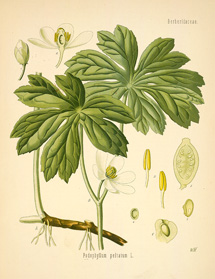Magical Mayapple
By Audrey Stallsmith

Down in the shady woodland
Where fern fronds are uncurled,
A host of green umbrellas
Are swiftly now unfurled.
Do they shelter fairy people
From sudden pelting showers
Or are the leaves but sunshades
To shield the waxen flowers?
"Mandrakes" by Minnie Curtis Wait
Mayapples do, indeed, pop up their little umbrellas by the hundreds at the edges of woodlands this time of year. Reaching only about one to one and a half feet tall with pristine flowers hidden under their parsols, they have a magical quality.
Enraptured by "A Mayapple Flower," Madison Julius Cawein writes of a fragrancy that "like the cup of Comus, drugs with dreams/ This woodland place so drowsed with mystery. What miracle evolved you from the mold?"
He seems to be one of the few to enjoy that flower's scent, however, as many people find it nauseating. Although charming when viewed from a distance, mayapple can show a darker side up close. The plant is almost entirely poisonous, and was once used by Native Americans to commit suicide. Its resin can also irritate the skin of unwary persons. No wonder the wildflower is sometimes called devil's apple or American mandrake, in comparison to the ominous European herb of that name.
Mayapple's botanical title, Podophyllum peltatum, derives from podos ("foot") and phyllon ("leaf") as the plant is also thought to bear some resemblance to a duck's foot. The species name, peltatum, on the other hand, suggests a shield.
The only edible part of mayapples are the actual apples, rose-hip-like, plum-sized fruits that turn yellow when ripe in mid to late summer, at about the same time the plants are going dormant. Those fruits, sometimes called wild lemons, must be picked when very ripe and soft to avoid any toxicity. And it's still not a good idea to eat too many of them!
In "Time of Clearer Twitterings," James Whitcomb Riley asks "And will any poet sing/
Of a lusher, richer thing/
Than a ripe May-apple, rolled/
Like a pulpy lump of gold/
Under thumb and finger-tips,/
And poured molten through the lips?" Nobody seems to agree on what that fruit tastes like, however, with the comparisons varying from lemon to melon to passion fruit.
Although once employed in small amounts as an emetic (inducer of vomiting), purgative (violent laxative), or vermifuge (expeller of intestinal worms), the mayapple plant is really too dangerous to be used as a home remedy. Fortunately, scientists are managing to derive some anti-tumor drugs from the toxic tubers. So mayapple may turn out to be a life-saver after all.
Its fresh green also contributes much to the unrestrained exuberance of spring, when everything seems to burst into life and bloom at once. Jake Falstaff caught some of that friskiness in his "Beautiful Sunday" poem, in which he describes an old and sedate horse suddenly kicking up its heels, and adds:
About 14 hundred May-apple stems,
With their parasols up, marched down the hill
And all the spring beauties turned up
Their pale, peaked noses
And said, ‘Don’t them May-apples
Think they’re somebody
With their bumbershoots up!
Podophyllum peltatum image is from Kohler's Medizinal-Pflanzen, courtesy of the Missouri Botanical Garden.








